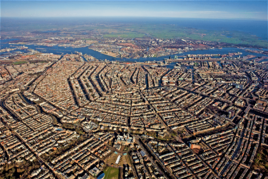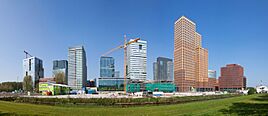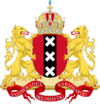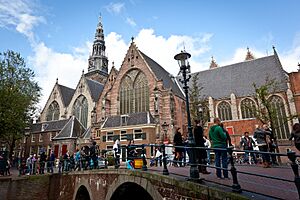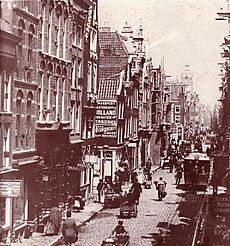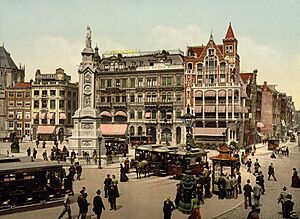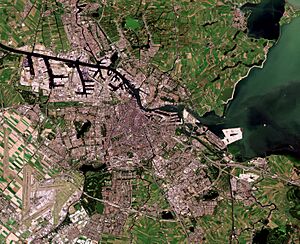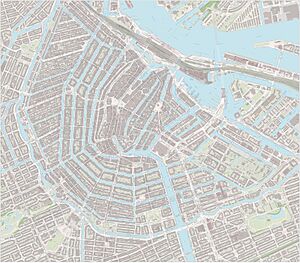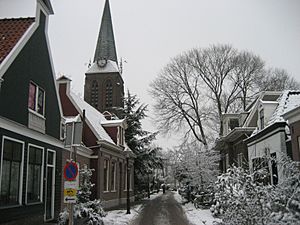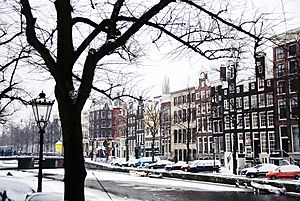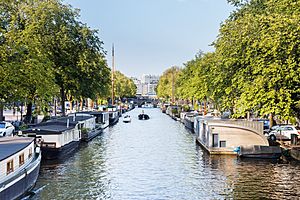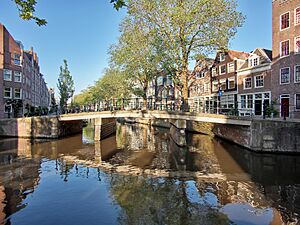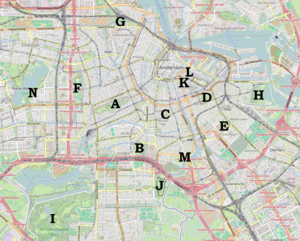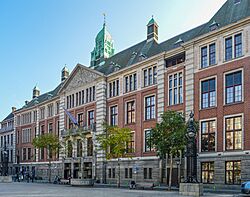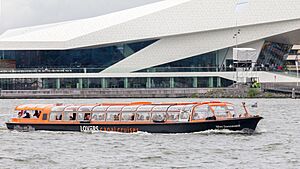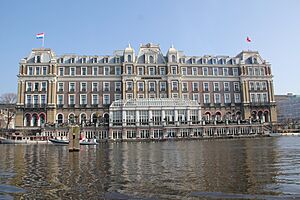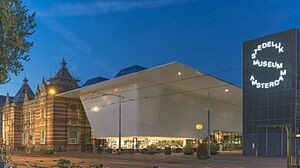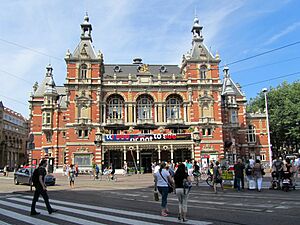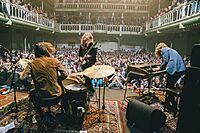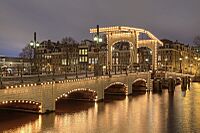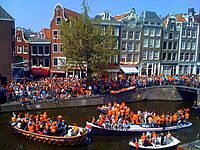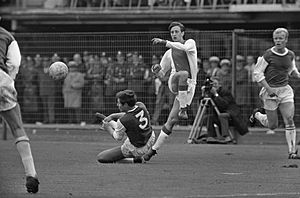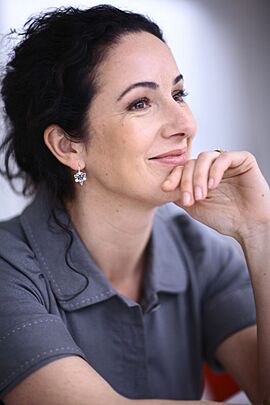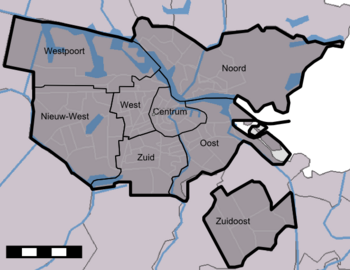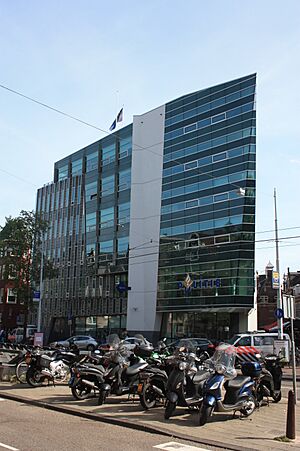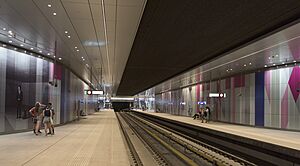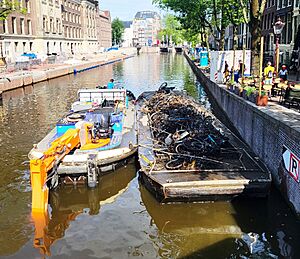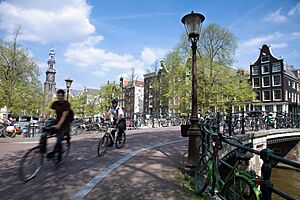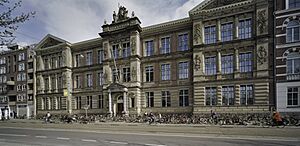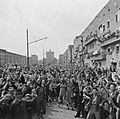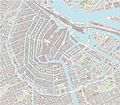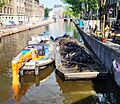Amsterdam facts for kids
Quick facts for kids
Amsterdam
|
|||||
|---|---|---|---|---|---|
|
Capital city and municipality
|
|||||
|
Aerial view of the canals of Amsterdam
Keizersgracht/Reguliersgracht
Royal Palace on Dam Square
Royal Concertgebouw
Zuidas business district under construction
|
|||||
|
|||||
| Nicknames:
The Venice of the North, Mokum, Damsko
|
|||||
| Motto(s):
Heldhaftig, Vastberaden, Barmhartig (Valiant, Steadfast, Compassionate)
|
|||||

Location of Amsterdam municipality
|
|||||
| Country | Netherlands | ||||
| Province | North Holland | ||||
| Region | Metropolitan Region Amsterdam | ||||
| Founded | c. 1275 | ||||
| City Hall | Stopera | ||||
| Boroughs |
7 boroughs, 1 urban area
|
||||
| Government | |||||
| • Body | Municipal council | ||||
| Area | |||||
| • Municipality | 219.32 km2 (84.68 sq mi) | ||||
| • Land | 165.76 km2 (64.00 sq mi) | ||||
| • Water | 53.56 km2 (20.68 sq mi) | ||||
| • Metro region | 2,580.26 km2 (996.24 sq mi) | ||||
| • Randstad | 6,296.91 km2 (2,431.25 sq mi) | ||||
| Elevation | -2 m (−6.6 ft) | ||||
| Population
(June 2024)
|
|||||
| • Municipality | 933,680 | ||||
| • Density | 4,908/km2 (12,710/sq mi) | ||||
| • Urban | 1,477,213 | ||||
| • Metro region | 2,480,394 | ||||
| • Randstad | 8,116,000 | ||||
| Demonym(s) | Amsterdammer | ||||
| GDP | |||||
| • Metro region | €201.100 billion (2022) | ||||
| • Randstad | €510.181 billion (2022) | ||||
| Time zone | UTC+1 (CET) | ||||
| • Summer (DST) | UTC+2 (CEST) | ||||
| Postcode |
1000–1183
|
||||
| Area code | 020 | ||||
| GeoTLD | .amsterdam | ||||
Amsterdam is the official capital and largest city of the Netherlands. It is located in the province of North Holland. In June 2024, the city had a population of over 933,000 people. Amsterdam is often called the "Venice of the North" because of its many canals. These canals are so special that they are a UNESCO World Heritage Site.
The city started as a small fishing village in the 12th century. It grew into a major world port during the 17th century, known as the Dutch Golden Age. During this time, the Netherlands was a very powerful country in trade and finance. Amsterdam became a center for art and new ideas. In the 19th and 20th centuries, the city expanded with new neighborhoods. Amsterdam is known for being open-minded and welcoming. Cycling is a huge part of daily life, with many bike paths everywhere.
Some of Amsterdam's most famous places include its historic canals, the Rijksmuseum (a national art museum), the Van Gogh Museum, and Dam Square. On Dam Square, you can find the Royal Palace of Amsterdam. Other popular spots are the Anne Frank House, the Concertgebouw concert hall, and the NEMO science museum. Millions of visitors come to Amsterdam every year to see its beautiful canals and old canal houses.
The Amsterdam Stock Exchange, started in 1602, is thought to be the world's oldest "modern" stock market. Amsterdam is a very important city for business and culture in Europe. Many big Dutch companies have their main offices here. Also, many large international companies, like Uber and Netflix, have their European headquarters in Amsterdam. Even though Amsterdam is the capital, the main government offices and foreign embassies are in The Hague.
In 2022, Amsterdam was ranked as one of the best cities to live in globally. It was also ranked as a top tech hub. The Port of Amsterdam is the fifth largest port in Europe. Schiphol Airport is the busiest airport in the Netherlands and one of the busiest in Europe. Amsterdam is also one of the most multicultural cities in the world, with people from about 180 different countries living there. Famous people from Amsterdam's past include painters Rembrandt and Vincent van Gogh, and the diarist Anne Frank.
Contents
- Exploring Amsterdam's Past
- Amsterdam's Geography
- People and Culture of Amsterdam
- City Layout and Buildings
- Amsterdam's Economy
- Arts and Entertainment
- Sports in Amsterdam
- How Amsterdam is Governed
- Getting Around Amsterdam
- Learning in Amsterdam
- Media and Entertainment
- Sister Cities
- Images for kids
- See also
Exploring Amsterdam's Past
Early Beginnings
Amsterdam was built on wet, marshy land, so it was founded later than other cities in the Low Countries. However, farmers lived in the area around the IJ river and the Amstel river about three thousand years ago. These early settlements were small and temporary because the land was very wet.
A big change happened in 1170 with a major flood. This flood turned the shallow IJ river into a wide bay, connecting the Amstel river to the sea. This made the river flow better and the land drier, which was perfect for building a permanent settlement. The new settlement focused on trade and transport, not farming. A dam was built on the Amstel river between 1264 and 1275. The name "Amsterdam" comes from "Amstel" (the river) and "dam" (the dam). In 1275, the people living near the dam were given special rights to travel without paying tolls. By 1327, the city was known as Aemsterdam.
Growing in the Middle Ages
Amsterdam gained city rights around 1300 or 1306. In 1345, a religious event made the city an important place for pilgrimage. Many people traveled to Amsterdam for this reason.
From the 14th century, Amsterdam became rich through trade, especially with the Hanseatic League. In the 15th century, the city started its own trade routes to the Baltic Sea, bringing in grain and timber. This made Amsterdam a major market for goods in Europe. The city also became very successful in the herring fishing industry. New ways of preparing and transporting herring allowed Dutch fishermen to dominate the market. This success in herring trade helped set up the city for its future as a global trading center during the Dutch Golden Age.
Challenges and Growth
In the 16th century, the Netherlands was part of the Spanish kingdom. The Dutch people rebelled against Spanish rule, partly because of new taxes and religious differences. This led to the Eighty Years' War, which resulted in the Netherlands becoming independent. The new Dutch Republic was known for being more tolerant of different religions. Many people seeking safety, like Jews from Spain and Portugal, and Protestant Huguenots from France, came to Amsterdam. This made Amsterdam a center for free thinking and printing.
The Golden Age of Amsterdam
The 17th century was Amsterdam's Golden Age. It became one of the wealthiest cities in the world. Ships from Amsterdam sailed all over the globe, creating a huge trading network. Amsterdam's merchants were key players in the Dutch East India Company and the Dutch West India Company. These companies helped establish Dutch colonies around the world.
Amsterdam was Europe's most important trading hub and a leading financial center. In 1602, the Amsterdam office of the Dutch East India Company created the world's first stock exchange. The Bank of Amsterdam started in 1609, helping Dutch merchants with their banking needs.
Amsterdam was also involved in the transatlantic trade of enslaved people. The city was a major port for ships involved in this trade, which continued until the Netherlands stopped its involvement in 1814. In 2021, the mayor of Amsterdam apologized for the city's role in this historical practice.
Decline and Modern Times
Amsterdam's wealth decreased in the 18th and early 19th centuries due to wars with England and France. During the time of Napoleon, Amsterdam's importance was at its lowest. However, when the United Kingdom of the Netherlands was formed in 1815, things started to improve.
The late 19th century is sometimes called Amsterdam's second Golden Age. New museums, a railway station, and the Concertgebouw were built. The Industrial Revolution also reached the city. New canals, like the Amsterdam–Rhine Canal and the North Sea Canal, were dug. These canals greatly improved trade with Europe and the rest of the world.
20th Century and Beyond
Before World War I, Amsterdam began to expand with new suburbs. Even though the Netherlands stayed neutral in the war, Amsterdam faced food and fuel shortages, leading to riots.
In 1921, some nearby towns joined Amsterdam. The city continued to grow between the wars. During World War II, Nazi Germany invaded the Netherlands in 1940. Many Amsterdam citizens bravely helped hide Jewish people, risking their own lives. Sadly, over 100,000 Dutch Jews, including 60,000 from Amsterdam, were sent to concentration camps. Very few survived.
In February 1941, after some arrests of Jewish people, a large protest called the February strike took place. About 300,000 people protested against the arrests. However, the German authorities responded harshly. The most famous person deported was Anne Frank, whose hiding place was discovered in 1944. She died in a concentration camp in early 1945.
At the end of World War II, Amsterdam was in a difficult situation. Food and fuel were very scarce. People had to eat unusual things to survive. The city was finally freed by Canadian forces on May 5, 1945.

After the war, many new suburbs were built to provide modern, affordable housing. The city center had fallen into disrepair. There were plans to rebuild large parts of it, including new roads for cars. A metro system started in 1977. However, large-scale demolitions in the old Jewish neighborhood led to protests, known as the Nieuwmarktrellen (Nieuwmarkt riots). These protests stopped many of the demolition plans.
Today, the city center has been beautifully restored. Many buildings are now protected monuments. In 2010, the Grachtengordel (the three main canals) was added to the UNESCO World Heritage List.
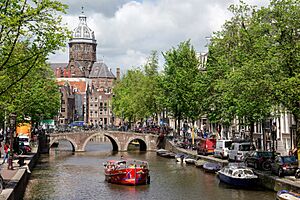
In the 21st century, Amsterdam's city center has become very popular with tourists. The number of visitors grew from 10 million to 17 million between 2012 and 2015. This has caused real estate prices to rise, making it harder for local people to afford living there. A new metro line connecting the north and south parts of the city was completed in 2018. Since 2014, the city has focused on improving and expanding areas around the city center.
Amsterdam's Geography
Amsterdam is located in the western part of the Netherlands, in the province of North Holland. The Amstel river flows into the city center and connects to many canals, which then lead to the IJ bay. Amsterdam is about 2 meters (6.5 feet) below sea level. The land around it is very flat, made up of large polders (land reclaimed from water). The Amsterdamse Bos, an artificial forest, is in the southwest. Amsterdam is connected to the North Sea by the long North Sea Canal.
Amsterdam is a very built-up city. The city itself covers about 219.4 square kilometers (84.7 square miles). Parks and nature areas make up 12% of Amsterdam's land.
Waterways and Canals
Amsterdam has over 100 kilometers (62 miles) of canals, and most of them can be used by boats. The three main canals are the Prinsengracht, the Herengracht, and the Keizersgracht.
In the Middle Ages, Amsterdam was surrounded by a moat called the Singel. This moat now forms the innermost ring of canals, giving the city center a horseshoe shape. The city also has a large seaport. Amsterdam is often compared to Venice because it has about 90 islands connected by more than 1,200 bridges.
Climate and Weather
Amsterdam has an oceanic climate, meaning it's strongly affected by the nearby North Sea. Winds usually come from the west.
Frosts happen mostly when cold winds blow from inland Europe. Even then, because Amsterdam is surrounded by water and has a "heat island effect" (the city itself stays warmer), temperatures rarely drop below -5°C (23°F) at night.
Summers are moderately warm with some hot and humid days, and it rains sometimes each month. The average high in August is 22.1°C (71.8°F). Days with more than 1 millimeter (0.04 inches) of rain are common, about 133 days a year.
Amsterdam's average yearly rainfall is 838 millimeters (33 inches). Much of this rain is light or in short showers. Cloudy and damp days are common from October to March.
| Climate data for Amsterdam Airport Schiphol | |||||||||||||
|---|---|---|---|---|---|---|---|---|---|---|---|---|---|
| Month | Jan | Feb | Mar | Apr | May | Jun | Jul | Aug | Sep | Oct | Nov | Dec | Year |
| Record high °C (°F) | 14.0 (57.2) |
16.6 (61.9) |
24.1 (75.4) |
28.0 (82.4) |
31.5 (88.7) |
33.2 (91.8) |
36.3 (97.3) |
34.5 (94.1) |
31.0 (87.8) |
25.3 (77.5) |
18.2 (64.8) |
15.5 (59.9) |
36.3 (97.3) |
| Mean daily maximum °C (°F) | 6.2 (43.2) |
6.9 (44.4) |
10.1 (50.2) |
14.3 (57.7) |
17.8 (64.0) |
20.3 (68.5) |
22.5 (72.5) |
22.4 (72.3) |
19.2 (66.6) |
14.7 (58.5) |
10.0 (50.0) |
6.9 (44.4) |
14.3 (57.7) |
| Daily mean °C (°F) | 3.8 (38.8) |
4.1 (39.4) |
6.5 (43.7) |
9.8 (49.6) |
13.3 (55.9) |
16.0 (60.8) |
18.1 (64.6) |
18.0 (64.4) |
15.1 (59.2) |
11.3 (52.3) |
7.4 (45.3) |
4.6 (40.3) |
10.7 (51.2) |
| Mean daily minimum °C (°F) | 1.2 (34.2) |
1.0 (33.8) |
2.8 (37.0) |
5.2 (41.4) |
8.6 (47.5) |
11.3 (52.3) |
13.5 (56.3) |
13.4 (56.1) |
11.0 (51.8) |
7.7 (45.9) |
4.5 (40.1) |
1.5 (34.7) |
6.8 (44.3) |
| Record low °C (°F) | −16.3 (2.7) |
−19.7 (−3.5) |
−16.7 (1.9) |
−4.7 (23.5) |
−1.1 (30.0) |
2.3 (36.1) |
5.0 (41.0) |
5.0 (41.0) |
2.0 (35.6) |
−3.4 (25.9) |
−8.1 (17.4) |
−14.8 (5.4) |
−19.7 (−3.5) |
| Average precipitation mm (inches) | 66.5 (2.62) |
54.7 (2.15) |
51.8 (2.04) |
39.6 (1.56) |
53.9 (2.12) |
64.8 (2.55) |
82.3 (3.24) |
98.6 (3.88) |
84.4 (3.32) |
86.7 (3.41) |
85.3 (3.36) |
81.7 (3.22) |
850.3 (33.48) |
| Average snowfall cm (inches) | 4.8 (1.9) |
5.3 (2.1) |
2.8 (1.1) |
0.2 (0.1) |
0 (0) |
0 (0) |
0 (0) |
0 (0) |
0 (0) |
0.1 (0.0) |
0.8 (0.3) |
3.9 (1.5) |
17.9 (7.0) |
| Average precipitation days (≥ 1 mm) | 12.2 | 10.8 | 9.7 | 8.6 | 8.9 | 9.7 | 10.9 | 11.6 | 10.9 | 12.4 | 13.4 | 14.1 | 133.2 |
| Average relative humidity (%) | 87.3 | 84.9 | 81.0 | 75.6 | 74.5 | 76.3 | 77.2 | 78.3 | 81.8 | 84.9 | 88.4 | 88.5 | 81.6 |
| Mean monthly sunshine hours | 69.0 | 94.3 | 146.0 | 197.7 | 230.7 | 217.2 | 225.4 | 203.5 | 154.2 | 116.9 | 66.8 | 58.2 | 1,779.9 |
| Percent possible sunshine | 26.8 | 33.6 | 39.6 | 47.4 | 47.4 | 43.4 | 44.7 | 44.6 | 40.4 | 35.3 | 25.2 | 24.1 | 37.7 |
| Average ultraviolet index | 1 | 1 | 2 | 4 | 5 | 6 | 6 | 5 | 4 | 2 | 1 | 0 | 3 |
| Source: Royal Netherlands Meteorological Institute (1991–2020 normals) (1971–2000 extremes) and Weather Atlas (UV index) | |||||||||||||
People and Culture of Amsterdam
Population Changes Over Time
In 1300, Amsterdam had about 1,000 people. While many towns in Holland saw their populations shrink in the 15th and 16th centuries, Amsterdam's population grew. This was mainly due to profitable trade, especially in grain from the Baltic Sea.
The population really took off during the Dutch Revolt. Many people from the southern parts of the Netherlands moved north, especially after the city of Antwerp was captured in 1585. Jewish people from Spain, Portugal, and Eastern Europe also settled in Amsterdam, along with Germans and Scandinavians. Between 1585 and 1610, Amsterdam's population more than doubled. By 1600, it was around 50,000. In the 1660s, it reached 200,000. For most of the 18th century, the population stayed around 240,000.
In 1750, Amsterdam was the fourth largest city in Western Europe. This was impressive because it wasn't even the capital or government seat of the Dutch Republic.
The city's population dropped in the early 19th century, going below 200,000 in 1820. But in the second half of the 19th century, industrial growth led to new population increases. Amsterdam's population reached its highest point of 872,000 in 1959. It then declined for a few decades as people moved to new "growth centers" outside the city. Between 1970 and 1980, Amsterdam saw a sharp drop in population. By 1985, it had only 675,570 residents. However, in the 2010s, people started moving back to the city, leading to new growth, much of it from immigration.
Diversity and Newcomers
In the 16th and 17th centuries, many non-Dutch people moved to Amsterdam. These included Protestant Huguenots, Flemings, Sephardic Jews, and people from Westphalia. The Huguenots came after 1685, and the Flemish Protestants during the war against Spain. Westphalians came mostly for economic reasons. Before World War II, 10% of the city's population was Jewish, but only 20% of them survived the war.
After World War II, Amsterdam saw many new cultures and religions arrive. With 180 different nationalities, Amsterdam is one of the most diverse cities in the world. About 50% of the city's population has at least one parent who was born outside the Netherlands.
The first large group of immigrants in the 20th century came from Indonesia after it gained independence. In the 1960s, workers from Turkey, Morocco, Italy, and Spain moved to Amsterdam. After Suriname became independent in 1975, many Surinamese people settled in Amsterdam, especially in the Bijlmer area. Other immigrants, including refugees, came from various parts of Europe, the Americas, Asia, and Africa.
In 2006, about one-fifth of Amsterdam's population was of non-Western origin, and more than 30% of the city's children. By 2023, people of Dutch origin were a minority in 40% of Amsterdam's neighborhoods. People from non-Western backgrounds tend to live in specific areas, especially in Nieuw-West, Zeeburg, Bijlmer, and parts of Amsterdam-Noord.
In 2015, Christians were the largest religious group in the city (28% of the population). Islam was the next largest (7.1%), mostly Sunni. Amsterdam has offered free Dutch language courses to immigrants, which has helped many.
| Origin | ||||||||||||||
|---|---|---|---|---|---|---|---|---|---|---|---|---|---|---|
| Background group | 1996 | 2000 | 2005 | 2010 | 2015 | 2020 | 2024 | |||||||
| Numbers | % | Numbers | % | Numbers | % | Numbers | % | Numbers | % | Numbers | % | Numbers | % | |
| Dutch natives | 419,863 | 58.5% | 406,727 | 55.6% | 384,155 | 51.7% | 384,480 | 50% | 402,105 | 48.9% | 387,775 | 44.43% | 375,842 | 40.4% |
| Western migration background | 94,955 | 13.2% | 97 232 | 13.3% | 104,452 | 14.1% | 114,730 | 14.9% | 134,524 | 16.4% | 170 164 | 19.5% | – | – |
| 18 475 | 17 451 | 17 070 | 17 099 | 17 688 | 19 374 | 21,179 | ||||||||
| 7 817 | 7 927 | 9 315 | 9 841 | 11 463 | 15 338 | 17,028 | ||||||||
| 4 015 | 4 785 | 5 891 | 6 540 | 7 872 | 11 582 | 14,696 | ||||||||
| 3 509 | 3 689 | 4 148 | 4 972 | 7 062 | 11 462 | 14,427 | ||||||||
| 3 038 | 3 456 | 4 058 | 4 945 | 6 379 | 9 316 | 11,972 | ||||||||
| Non-Western migration background | 203,301 | 28.3% | 227 329 | 31.1% | 254,176 | 34.2% | 268,247 | 35% | 285,123 | 34.7% | 314,818 | 36.07% | – | – |
| 47 723 | 54 722 | 64 385 | 69 433 | 74 254 | 77,210 | 8.85% | 79,157 | |||||||
| 69 095 | 71 218 | 70 380 | 68 938 | 66 638 | 64,218 | 7.36% | 62 174 | |||||||
| 30 864 | 33 705 | 37 957 | 40 365 | 42 375 | 44,465 | 5.09% | 46 820 | |||||||
| 28 489 | 28 037 | 26 900 | 26 436 | 26 091 | 24,075 | 2.76% | 23,242 | |||||||
| 10 003 | 11 122 | 11 500 | 11 707 | 12 141 | 12,174 | 1.39% | 12 833 | |||||||
| 6 859 | 8 574 | 10 167 | 10 944 | 11 884 | 11 884 | 13 864 | ||||||||
| 677 | 1 179 | 991 | 1 071 | 1 492 | 1 714 | 2 010 | ||||||||
| 1 027 | 2 113 | 2 536 | 2 626 | 2 701 | 3 080 | 3 352 | ||||||||
| Non-Dutch migration background | 298,256 | 41.5% | 324,561 | 44.4% | 358,628 | 48.3% | 382,977 | 50% | 419,647 | 51.9% | 484,982 | 55.6% | 555,456 | 59.6% |
| Total | 718,119 | 100% | 731,288 | 100% | 742,783 | 100% | 767,457 | 100% | 821,752 | 100% | 872,757 | 100% | 931,298 | 100% |
Religious Diversity
Religion in Amsterdam (2015) Non affiliated (62.2%) Catholic Church (13.3%) Protestant Church (9.8%) Other Christian (5.8%) Islam (7.1%) Hinduism (1.1%) Buddhism (1.0%) Judaism (0.7%)
In 1578, Amsterdam joined the revolt against Spanish rule. Catholic priests were removed from the city, and Calvinism became the main religion. It was not allowed to openly practice Roman Catholicism for a long time. This led to "hidden churches" where Catholics, some Jews, and other Protestants worshipped secretly.
Many foreigners of different religions came to Amsterdam in the 17th century. These included Sephardic Jews from Spain and Portugal, Huguenots from France, and Lutherans. In 1603, Jewish people were allowed to practice their religion openly. The first synagogue was built in 1639. Jewish people even called Amsterdam the "Jerusalem of the West".
In the second half of the 17th century, many Ashkenazi Jews from Central and Eastern Europe came to Amsterdam, often fleeing difficult situations. They built their own synagogues and influenced the local language. Most Jewish people lived in the eastern part of the city.
Catholic churches began to be built again in Amsterdam after 1853. One famous architect, Pierre Cuypers, designed many Catholic churches, as well as the Amsterdam Centraal station and the Rijksmuseum.
Historically, Amsterdam was mostly Christian. In 1900, Christians made up 70% of the population. However, immigration has changed the religious makeup of the city. Hinduism was introduced by people from Suriname, and various types of Islam came from different parts of the world. Islam is now the largest non-Christian religion in Amsterdam.
City Layout and Buildings
Amsterdam spreads out south from the Amsterdam Centraal station and Damrak. The oldest part of the city is called De Wallen. This area is east of Damrak. South of De Wallen is the old Jewish quarter, Waterlooplein.
The old canals of Amsterdam, called grachten, surround the city center. Homes along these canals have interesting gabled roofs. Beyond the main canals are older neighborhoods like Jordaan and de Pijp. The Museumplein (Museum Square), with its major museums, and the Vondelpark, a 19th-century park, are also outside the main canal area.
Some parts of the city are polders, which are lands reclaimed from water. You can often tell by names ending in -meer, meaning "lake," like Bijlmermeer.
Amsterdam's Famous Canals
Amsterdam's canal system was carefully planned. In the early 17th century, when many people were moving to the city, a big plan was made. It involved four half-circles of canals that connected to the IJ bay. These are known as the Grachtengordel. Three of these canals were mainly for homes: the Herengracht, Keizersgracht, and Prinsengracht. The fourth, outermost canal is the Singelgracht.
The canals were used for defense, managing water, and transport. They acted as a moat with earthen walls and gates. Construction began in 1613 and moved from west to east. The southern part of the canals was finished by 1656. Over the years, some canals have been filled in and turned into streets or squares.
City Expansion and Modern Planning
After the canals were built in the 17th century, Amsterdam didn't grow much for two centuries. In the 19th century, Samuel Sarphati created a plan to build new houses, public buildings, and streets just outside the main canal area. His main goal was to improve public health.
Later, engineers Jacobus van Niftrik and Jan Kalff designed a ring of 19th-century neighborhoods around the city center. Most of these areas became home to working-class families.
To deal with overcrowding, two new plans were made in the early 20th century: Plan Zuid (designed by Berlage) and West. These plans involved building new neighborhoods with housing blocks for all types of people.
After World War II, large new neighborhoods were built in the western, southeastern, and northern parts of the city. These areas had big housing blocks, green spaces, and wide roads for cars. Examples include the Westelijke Tuinsteden in the west and the Bijlmer in the southeast.
Architectural Styles

Amsterdam has a rich history of buildings. The oldest building is the Oude Kerk (Old Church), built in 1306. The oldest wooden building is Het Houten Huys at the Begijnhof, built around 1425. It's one of the few examples of Gothic architecture left in Amsterdam.
In the 16th century, wooden buildings were replaced with brick ones. Many buildings from this time were built in the Renaissance style, with recognizable stepped gables. Amsterdam developed its own Renaissance style, following the ideas of architect Hendrick de Keyser. The Westerkerk is a famous building he designed.
In the 17th century, baroque architecture became popular, especially during Amsterdam's Golden Age. Key architects of this style included Jacob van Campen and Philips Vingboons. The Royal Palace of Amsterdam on Dam Square is a famous baroque building.
In the 18th century, French culture influenced Amsterdam's architecture. Around 1815, architects started using different "neo-styles." Many Gothic-style buildings from this time are actually neo-gothic. In the late 19th century, the Jugendstil or Art Nouveau style became popular. Many new buildings near the city center, like those around Museum Square, show this style.
Before the modern era, Art Deco was popular. Amsterdam had its own version called the Amsterdam School. Whole neighborhoods, like the Rivierenbuurt, were built in this style. Buildings in the Amsterdamse School style often have highly decorated facades with unique windows and doors.
The old city center shows all the architectural styles from before the late 19th century. Newer styles like Jugendstil are mostly found in neighborhoods built in the early 20th century. Most historic buildings in the city center are houses, like the famous merchant houses along the canals.
Parks and Green Spaces
Amsterdam has many parks, open spaces, and squares. The Vondelpark is the largest park in the city, located in the Oud-Zuid neighborhood. It gets about 10 million visitors each year. The park has an open-air theater, a playground, and places to eat. The Beatrixpark in the Zuid borough is named after Queen Beatrix.
Between Amsterdam and Amstelveen is the Amsterdamse Bos ("Amsterdam Forest"), the city's largest recreation area. It's about 1,000 hectares (2,500 acres) in size, roughly three times the size of Central Park. The Amstelpark in the Zuid borough has the Rieker windmill, built in 1636. Other parks include the Sarphatipark, Oosterpark, and Westerpark. The city also has three beaches: Nemo Beach, Citybeach "Het stenen hoofd" (Silodam), and Blijburg.
Amsterdam has many open squares (plein in Dutch). Dam Square, the city's main square, has the Royal Palace of Amsterdam and the National Monument. Museumplein is home to several museums, including the Rijksmuseum and Van Gogh Museum. Other squares include Rembrandtplein, Muntplein, Nieuwmarkt, Leidseplein, Spui, and Waterlooplein.
Amsterdam's Economy
Amsterdam is the financial and business center of the Netherlands. In a 2007 survey, Amsterdam was ranked among the top European cities for international businesses.
Many large companies and banks have their main offices in the Amsterdam area. These include AkzoNobel, Heineken International, ING Group, ABN AMRO, TomTom, and Philips. While some smaller offices are still along the historic canals, many companies have moved outside the city center. The Zuidas (South Axis) has become the new financial and legal hub. It houses the country's largest law firms and parts of big consulting firms, as well as the World Trade Centre (Amsterdam).
Other financial districts are located around Amsterdam Sloterdijk railway station, the Johan Cruyff Arena, and the Amstel railway station. Amsterdam's tallest building, the Rembrandt Tower, is in the Amstel area. Amsterdam is also working to become a "circular city" by 2050, aiming to reduce waste and reuse materials.
The Amsterdam Stock Exchange (AEX), now part of Euronext, is the world's oldest stock exchange. It is located near Dam Square in the city center.
Port and Tourism
The Port of Amsterdam is the fourth-largest port in Europe. In 2014, it handled 97.4 million tons of cargo. Amsterdam also has the biggest cruise port in the Netherlands, with over 150 cruise ships visiting each year. A new lock opened in IJmuiden in 2019, allowing the port to handle even more cargo.
Amsterdam is a very popular place for tourists in Europe. It receives over 5.34 million international visitors annually, plus 16 million day-trippers. The number of visitors has been growing steadily. Most hotels are in the city center. In 2017, 85% of hotel rooms were occupied. Most tourists (74%) come from Europe, with the largest non-European group from the United States.
The city sometimes has special themes to attract visitors. For example, 2006 was "Rembrandt 400" to celebrate the artist's 400th birthday.
In 2023, the city started a campaign to discourage certain types of tourism, especially focusing on young British men. This campaign aims to improve the city's reputation. The city also banned public smoking in certain areas to reduce disruptive behavior.
Shopping and Fashion
Shops in Amsterdam range from large department stores like De Bijenkorf to small specialty shops. High-end shops are found on streets like P.C. Hooftstraat. One of Amsterdam's busiest shopping streets is the narrow, medieval Kalverstraat. Other popular shopping areas include the Negen Straatjes (Nine Streets) and Haarlemmerdijk. The Negen Straatjes are known for their unique, privately owned shops.
The city also has many outdoor markets, such as the Albert Cuyp Market and Dappermarkt. Some markets are daily, while others are weekly.
Several fashion brands and designers are based in Amsterdam, including Iris van Herpen and Viktor & Rolf. Famous models like Doutzen Kroes started their careers here. Amsterdam has a garment center called the World Fashion Center.
Arts and Entertainment
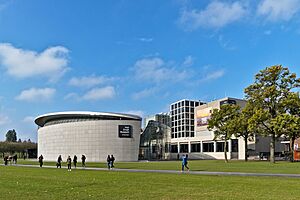
In the late 16th century, Amsterdam's poetry and drama groups held contests. In 1637, the first theater, Schouwburg, was built. In the 18th century, French theater became popular. The 19th century saw the building of the Rijksmuseum (1885) and Stedelijk Museum (1895). In 1888, the Concertgebouworkest orchestra was formed. The 20th century brought cinema, radio, and television. Many people who work in television live in Amsterdam.
Museums and Art
The most important museums in Amsterdam are on the Museumplein (Museum Square). This square was created in the late 19th century. The large Rijksmuseum is on one side, with a long pond in front that becomes an ice rink in winter. The Van Gogh Museum and Stedelijk Museum are also on the square. The Concertgebouw concert hall is across the street. Museumplein is a popular spot for festivals and outdoor concerts.
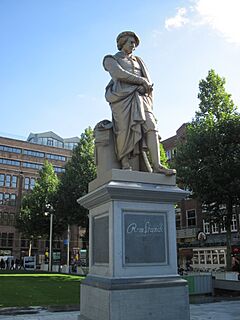
The Rijksmuseum has the largest and most important collection of classical Dutch art. It opened in 1885 and has nearly a million objects. Rembrandt is the artist most connected to Amsterdam, and his famous painting The Night Watch is a highlight of the museum. The museum also has paintings by Johannes Vermeer and Frans Hals. Besides paintings, it has many decorative arts, from Delftware to giant dollhouses. The museum underwent a 10-year renovation and fully reopened in 2013. It is the most visited museum in Amsterdam.
Vincent van Gogh lived in Amsterdam for a short time, and there is a museum dedicated to his work. The museum has a permanent collection and a separate building for temporary exhibitions. Some of Van Gogh's most famous paintings, like The Potato Eaters and Sunflowers, are in the collection. It is the second most visited museum in Amsterdam.
Next to the Van Gogh Museum is the Stedelijk Museum, Amsterdam's main museum for modern art. It opened in 1895. Its collection includes works by artists like Piet Mondrian. After renovations, it reopened in 2012 with a new, unique extension.
Amsterdam has many other museums, from small ones like the Verzetsmuseum (Resistance Museum) and the Anne Frank House, to larger ones like the Tropenmuseum (Museum of the Tropics) and the Joods Historisch Museum (Jewish Historical Museum). The modern Nemo museum offers fun science exhibitions for children.
Music and Performing Arts

Amsterdam has a rich musical culture, with many songs celebrating the city. "Aan de Amsterdamse grachten" ("On the canals of Amsterdam") and "Geef mij maar Amsterdam" ("I prefer Amsterdam") are famous examples.
AFAS Live (formerly Heineken Music Hall) is a concert hall near the Johan Cruyff Arena. Many famous international pop artists perform there. Two other popular venues, Paradiso and the Melkweg, are near Leidseplein. They host a wide range of music, from indie rock to hip-hop. In 2012, the Ziggo Dome, a modern indoor music arena, opened near the Amsterdam Arena.
AFAS Live also hosts many electronic dance music festivals. Famous Trance DJs like Armin van Buuren and Tiesto are from the Netherlands and often perform in Amsterdam. Every October, the city hosts the Amsterdam Dance Event (ADE), one of the world's biggest electronic music festivals.
Amsterdam has a world-class symphony orchestra, the Royal Concertgebouw Orchestra. They perform at the Concertgebouw, known for its excellent sound quality. The city's opera house is next to the city hall, and the combined buildings are often called the Stopera. This complex is home to the Dutch National Opera and Dutch National Ballet.
Theater and Nightlife
Amsterdam has three main theater buildings.
The Stadsschouwburg at Leidseplein is home to the Toneelgroep Amsterdam theater group. The current building dates from 1894. The Dutch National Opera and Ballet is the main opera house. The Royal Theatre Carré was built as a circus in 1887 and is now used for musicals, comedy shows, and concerts.
The Netherlands has a tradition of cabaret or kleinkunst, which combines music, storytelling, and comedy. Famous Dutch cabaret artists include Wim Kan and Wim Sonneveld. The English-speaking comedy scene started with Boom Chicago in 1993.
Amsterdam is known for its lively nightlife. It has many cafés (bars), from modern to cozy. The typical Bruine Kroeg (brown café) has an old-fashioned feel with dim lights. Many cafés have outdoor seating in summer. Amsterdam also has many restaurants, offering a variety of international foods. The city has many dance clubs. The main nightlife areas for tourists are Leidseplein and Rembrandtplein.
Festivals and Events
In 2008, Amsterdam hosted 140 festivals and events. That same year, UNESCO named Amsterdam the World Book Capital for a year.
Famous festivals include Koningsdag (King's Day), held every year on April 27. Hundreds of thousands of people come to Amsterdam to celebrate. The whole city becomes crowded with people enjoying outdoor markets and music concerts.
The Holland Festival showcases performing arts. The yearly Prinsengrachtconcert is a classical music concert held on the Prinsen canal in August. The 'Stille Omgang' is a silent Roman Catholic procession held every March. Amsterdam Gay Pride is a yearly parade of boats on Amsterdam's canals, held on the first Saturday in August. The annual Uitmarkt is a three-day cultural event in late August, offering previews of many artists.
Sports in Amsterdam
Amsterdam is home to the Eredivisie football (soccer) club AFC Ajax. Their stadium, Johan Cruyff Arena, is in the southeast of the city. Before 1996, Ajax played at the De Meer Stadion or the Olympic Stadium.
In 1928, Amsterdam hosted the Summer Olympics. The Olympic Stadium built for the event has been restored and is now used for cultural and sports events, like the Amsterdam Marathon.
The city hosts the Dam to Dam Run, a 16-kilometer (10-mile) race from Amsterdam to Zaandam, and the Amsterdam Marathon. The ice hockey team Amstel Tijgers plays at the Jaap Eden ice rink.
Amsterdam has two American football teams: the Amsterdam Crusaders and the Amsterdam Panthers. The Amsterdam Pirates baseball team plays in the Dutch Major League. There are also three field hockey teams.
Since 1999, Amsterdam has honored its best sportsmen and women at the Amsterdam Sports Awards.
How Amsterdam is Governed
Amsterdam is a municipality governed by an elected municipal council, a municipal executive, and a mayor. Since 1981, Amsterdam has been divided into semi-independent areas called stadsdelen or 'districts'. There are now eight of these boroughs.
City Government Structure
Like all Dutch municipalities, Amsterdam has an elected municipal council and a mayor appointed by the government. The mayor is in charge of public order. On June 27, 2018, Femke Halsema became the first woman to be Mayor of Amsterdam. She started her six-year term on July 12, 2018. The municipal executive also includes eight 'alderpersons' chosen by the municipal council.
Amsterdam is divided into seven boroughs and the urban area of Weesp. This system was put in place in the 1980s to improve local management. The boroughs handle many local tasks. In 2010, many smaller boroughs merged into larger ones. In 2014, the boroughs lost some of their independent power, but they still have elected district committees that handle local matters.
Metropolitan Area and Capital Status
When people say "Amsterdam," they usually mean the municipality of Amsterdam. However, there are larger definitions of the Amsterdam area. The "Metropolitan Region Amsterdam" includes 15 municipalities and had a population of 2.33 million people. Amsterdam is also part of the larger Randstad area, which has a total population of over 6.6 million.
National Capital Role
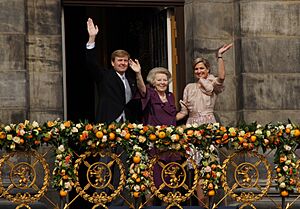
According to the Dutch Constitution, Amsterdam is the capital of the Netherlands. When a new king or queen is crowned, the ceremony takes place in Amsterdam, usually at the Nieuwe Kerk on Dam Square. However, the Dutch government, the royal family's main residence, and foreign embassies are all located in The Hague.
City Symbols
The coat of arms of Amsterdam has several historical parts. In the center are three St Andrew's crosses. These crosses are also on the flags of nearby towns. This part of the coat of arms is the basis for the flag of Amsterdam.
The Imperial Crown of Austria is also on the coat of arms. In 1489, an emperor gave Amsterdam the right to use a king's crown on its coat of arms. This was later replaced with an imperial crown. The lions on the coat of arms date from the late 16th century.
Finally, the city's official motto is Heldhaftig, Vastberaden, Barmhartig ("Heroic, Determined, Merciful"). This motto was given to the city in 1947 by Queen Wilhelmina to recognize Amsterdam's bravery during World War II.
Getting Around Amsterdam
Metro, Tram, and Bus
Amsterdam has 16 tram routes and five metro routes. All are run by the city's public transport company, Gemeentelijk Vervoerbedrijf (GVB), which also operates the city bus network.
Four free GVB ferries carry people and bikes across the IJ lake to Amsterdam-Noord. There are also private water taxis, a water bus, and canal cruises.
Regional and suburban buses are run by other companies. International bus services are also available from Amsterdam.
To make it easier to get to the city center, Amsterdam has P+R (Park and Ride) locations. Here, people can park their cars affordably and switch to public transport.
Driving in Amsterdam
Amsterdam was originally planned to be the center of the Netherlands' highway system. However, due to World War II and changing plans, only a few major highways start from the city today. The A10 ring road goes around the city and connects Amsterdam to the national highway network.
Interchanges on the A10 allow cars to enter the city using one of 18 "city roads." These city roads are smaller and sometimes shared with cyclists. Driving a car in the city center is not encouraged. Parking is expensive, and many streets are closed to cars or are one-way. The city government is also working to remove parking spaces to encourage other forms of transport.
Trains and Airport
Amsterdam has ten train stations operated by the Nederlandse Spoorwegen (Dutch Railways). Five of these are major stops for intercity trains: Sloterdijk, Zuid, Amstel, Bijlmer ArenA, and Amsterdam Centraal. Amsterdam Centraal is also an international train station, with services to many European countries.

Amsterdam Airport Schiphol is less than 20 minutes by train from Amsterdam Centraal station. It is the largest airport in the Netherlands and one of the busiest in Europe and the world. It handles over 68 million passengers per year and is a main base for several airlines. Although it's called Amsterdam Schiphol Airport, it's actually located in the nearby municipality of Haarlemmermeer.
Rotterdam The Hague Airport, a smaller international airport, is also within an hour's drive.
Cycling Culture
Amsterdam is one of the most bicycle-friendly large cities in the world. It has excellent facilities for cyclists, including bike paths and bike racks. There are also guarded bike storage garages.
In 2015, Amsterdam's 442,693 households owned 847,000 bicycles, which is about 1.91 bikes per household. Unfortunately, bike theft is common. Bicycles are used by almost everyone because they are convenient, the city is small, there are 400 kilometers (250 miles) of bike paths, the land is flat, and driving a car can be difficult.
Learning in Amsterdam
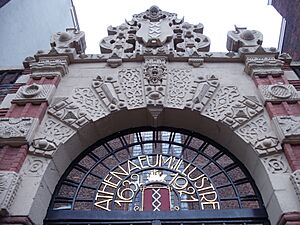
Amsterdam has two universities: the University of Amsterdam (UvA) and the Vrije Universiteit Amsterdam (VU). Other higher education institutions include an art school, a university of applied sciences, and an arts university. The International Institute of Social History in Amsterdam is one of the world's largest research centers for social history. Amsterdam's Hortus Botanicus, founded in the early 17th century, is one of the oldest botanical gardens in the world.
There are over 200 primary schools in Amsterdam. Some schools use special teaching methods like Montessori. Many schools are based on religion, including Roman Catholic, Protestant, and a growing number of Islamic schools. Jewish schools are found in the southern suburbs.
Amsterdam is known for having five independent grammar schools (Dutch: gymnasia): the Vossius Gymnasium, Barlaeus Gymnasium, St. Ignatius Gymnasium, Het 4e Gymnasium, and the Cygnus Gymnasium. These schools teach a classical curriculum, including Latin and classical Greek. While once thought to be old-fashioned, these schools have become popular again. Most secondary schools in Amsterdam offer different levels of education. The city also has various colleges for subjects like art, design, politics, and economics, which are open to international students.
Schools for foreign nationals in Amsterdam include the Amsterdam International Community School and the British School of Amsterdam.
Media and Entertainment
Amsterdam is an important center for national and international media. Some local newspapers include Het Parool, De Telegraaf, Trouw, de Volkskrant, and NRC.
Amsterdam is home to the second-largest Dutch commercial TV group, SBS Broadcasting Group. However, the town of Hilversum, southeast of Amsterdam, is considered the main "media city" of the Netherlands. Hilversum is the main center for radio and television broadcasting in the country.
Several movies have been filmed in Amsterdam, including the James Bond film Diamonds Are Forever, Ocean's Twelve, and The Hitman's Bodyguard. Amsterdam is also featured in John Green's book The Fault in Our Stars, which was made into a film partly set in Amsterdam.
Amsterdam appears as a multiplayer map in the video game Modern Warfare II and in Black Ops Cold War.
Sister Cities
 Manchester, Greater Manchester, United Kingdom, 2007
Manchester, Greater Manchester, United Kingdom, 2007 Zapopan, Jalisco, Mexico, 2011
Zapopan, Jalisco, Mexico, 2011
Images for kids
-
People celebrating the liberation of the Netherlands at the end of World War II on 8 May 1945
-
The 17th-century Canals of Amsterdam were listed as UNESCO World Heritage Sites in 2010, contributing to Amsterdam's fame as the "Venice of the North". Along with De Wallen, the canals are the focal point for tourists in the city.
-
Large-scale map of the city centre of Amsterdam, including sightseeing markers, as of April 2017[update].
-
The Royal Palace of Amsterdam, by architects Jacob van Campen and Daniël Stalpaert is characteristic of the architecture of the Dutch Baroque architecture.
-
The Rijksmuseum houses Rembrandt's The Night Watch.
-
The Van Gogh Museum houses the world's largest collection of Van Gogh's paintings and letters.
-
Rembrandt monument on Rembrandtplein
-
Coldplay performing at the Amsterdam Arena, 2016
-
The Concertgebouw or Royal Concert Hall houses performances of the Royal Concertgebouw Orchestra and other musical events.
-
AFC Ajax player Johan Cruyff, 1967
-
King Willem-Alexander, Princess Beatrix, and Queen Máxima greeting Amsterdammers from the Royal Palace of Amsterdam during Willem-Alexanders inauguration in 2013
-
The Amsterdam Metro is a mixed subway and above ground rapid transit system consisting of five lines.
-
Amsterdam Airport Schiphol ranks as Europe's third-busiest airport for passenger traffic.
-
The Agnietenkapel Gate at the University of Amsterdam, founded in 1632 as the Athenaeum Illustre
See also
 In Spanish: Ámsterdam para niños
In Spanish: Ámsterdam para niños


